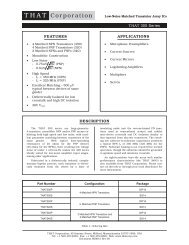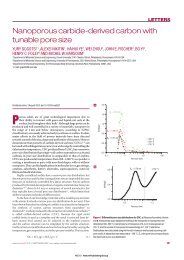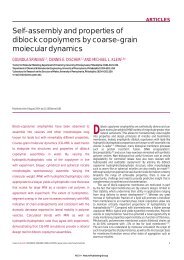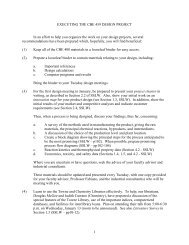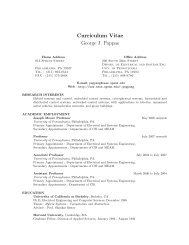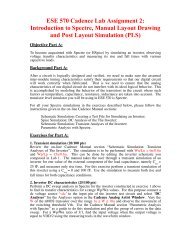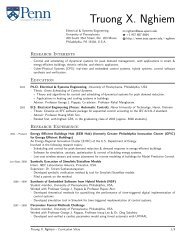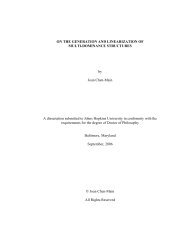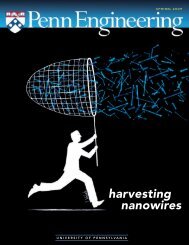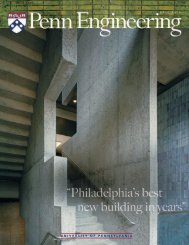Download PDF (9.49MB) - the School of Engineering and Applied ...
Download PDF (9.49MB) - the School of Engineering and Applied ...
Download PDF (9.49MB) - the School of Engineering and Applied ...
Create successful ePaper yourself
Turn your PDF publications into a flip-book with our unique Google optimized e-Paper software.
WWW.SEAS.UPENN.EDU<br />
The Nano Guru<br />
By Janelle Weaver<br />
Films made <strong>of</strong> nanoparticles are a crucial component<br />
found in everything from lithium ion batteries <strong>and</strong><br />
solar cells to <strong>the</strong> next generation <strong>of</strong> display devices<br />
<strong>and</strong> anti-fogging coatings for automobile windshields.<br />
One vexing problem facing engineers is that cracks<br />
routinely form in nanoparticle films during formation,<br />
interfering with <strong>the</strong>ir ability to work properly.<br />
Traditional techniques to prevent crack formation, such<br />
as adding substances to make <strong>the</strong> films stronger, can<br />
also compromise <strong>the</strong>ir function.<br />
With <strong>the</strong> goal <strong>of</strong> developing stronger, tougher<br />
nanoparticle films, Daeyeon Lee, assistant pr<strong>of</strong>essor<br />
<strong>of</strong> Chemical <strong>and</strong> Biomolecular <strong>Engineering</strong>, recently<br />
reported a new method to tackle this problem. By<br />
stacking multiple, thin nanoparticle layers while<br />
making films, he discovered that it’s possible to prevent<br />
<strong>the</strong> formation <strong>of</strong> cracks. Lee is also exploring ways to<br />
enhance <strong>the</strong> damage tolerance <strong>of</strong> nanoparticle films<br />
using non-spherical nanoparticles. He envisions this<br />
approach being useful for <strong>the</strong> development <strong>of</strong> flexible<br />
solar cells <strong>and</strong> batteries as well as o<strong>the</strong>r electrical <strong>and</strong><br />
optical devices that can resist cracking in response to<br />
mechanical stress.<br />
Despite <strong>the</strong> technical nature <strong>of</strong> this research, Lee loves<br />
to give playful summaries <strong>of</strong> his own work, according<br />
to Ph.D. c<strong>and</strong>idate Kwadwo Tettey, who joined <strong>the</strong><br />
lab in <strong>the</strong> spring <strong>of</strong> 2009. “Recently, he gave a talk at<br />
a venue in Philadelphia entitled Beers, Bubbles, <strong>and</strong><br />
Beyond,” Tettey says. “It’s interesting to see that he<br />
could break down his research to a very broad audience.<br />
He does this really well, <strong>and</strong> with a sense <strong>of</strong> humor.”<br />
Lee’s enthusiasm for science is contagious in <strong>the</strong> lab,<br />
Tettey adds. “He’s a really engaging person <strong>and</strong> very<br />
passionate about research in general. This attitude<br />
rubs <strong>of</strong>f on his students <strong>and</strong> keeps <strong>the</strong>m motivated.”<br />
Tettey is also inspired by Lee’s approach to scientific<br />
problem solving. “He likes to know why something<br />
SPRING 2013 n 6



